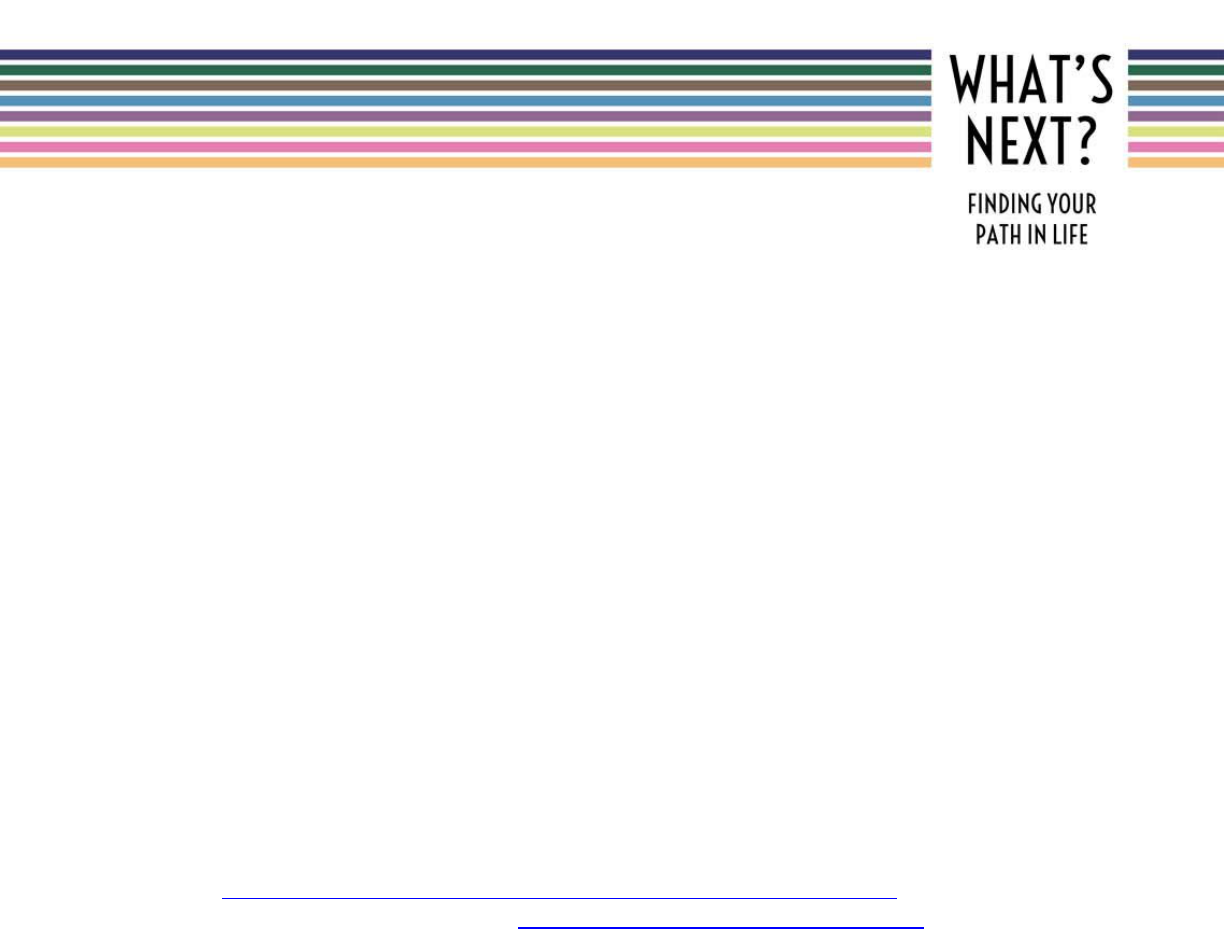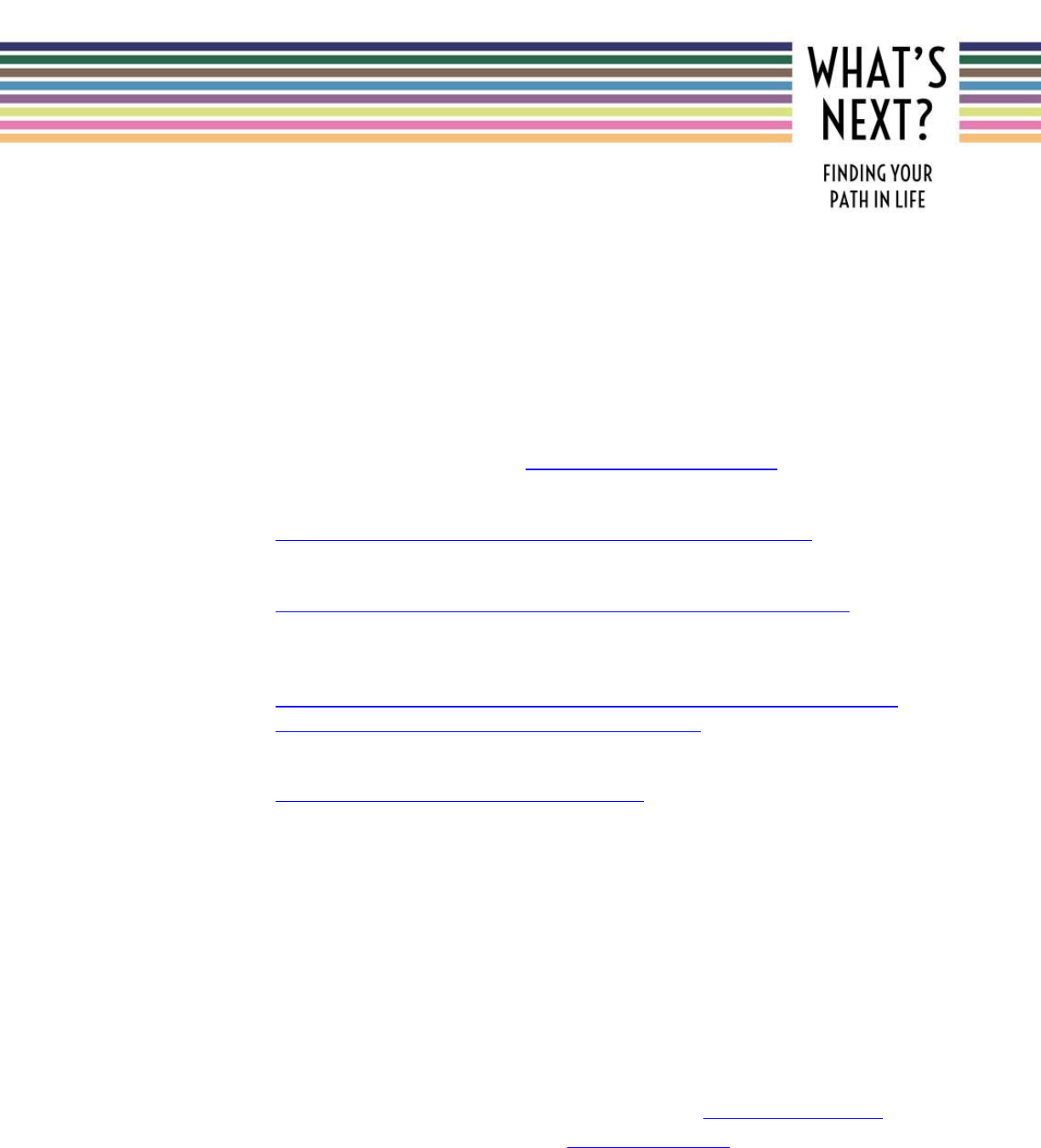
2
T
T
Soc
ial
Medicaid
Security
Waiver
Application
App
lication
r®-
Medicaid
I
Application
WHAT'S
NEXT?
FINDING
YOUR
PArn
IN
LIFE
Monthly tips and resources featured in What’s Next? are created for young adults, their families, and
supporters who are exploring options for life after high school in Indiana.
Health care coverage, services,
and supports: Applying for
Medicaid and the Medicaid waiver
Issue No. 8, March 24, 2021
In Indiana, when a student turns 18, they
must reapply for benefits they may have
been receiving while they were in school.
Admittedly, this process will probably be
one of the most challenging things on
your transition to-do list. For most young
adults, it will mean submitting at least
three different applications.
Knowing that up front, though, is half the
battle. Don’t worry. In this issue, we’ll
walk you through some of that and will
give you some key resources you’ll need.
Young adults who will need health care coverage from Medicaid and services and
supports provided by the Medicaid waiver must first go through the process of
redetermination. We talked about the steps in redetermination in last month’s issue of
What’s Next?
https://instrc.indiana.edu/doc/Whats-Next-Feb-2021-
Redetermination.pdf. We explained that in Indiana, the first step is to apply or reapply
for Supplemental Security Income (SSI) through the Social Security Administration.
It’s important to know:
Continued next page.
1

WHAT'S
NEXT?
FINDING
YOUR
PArn
IN
LIFE
• The first step, Social Security’s SSI eligibility determination, is the toughest for many
(but not all) people. That’s because the Social Security Administration is asking if you
can work, not specifically if you have a disability. That can make it more challenging to
qualify for SSI. (And on the positive side, some young adults who may not have been
eligible due to their parent’s income, may qualify now as an adult.)
• Medicaid, on the other hand, is about your health care coverage for things like doctor’s
visits, hospitalizations, medications, and some therapies.
• And the Medicaid waiver is about making sure you have the supports and services that
will help you live your best life. Personal care assistance, transportation, extended
supports at work, special therapies are all examples of waiver supports.
Three different issues. Three separate applications. Three different agencies overseeing each of
those processes.
You may be eligible, but you still need to apply
In this issue of What’s Next?, we’ll talk about the application for Medicaid and the Medicaid
waiver. That means we’re assuming you’ve already been through step one, and Social Security
has determined that you (or, if you are a parent, your son or daughter with a disability who is
over the age of 18) are eligible to receive SSI.
The good news is if Social Security has determined you
are eligible for SSI, you will, in most cases, automatically
be eligible for Indiana Medicaid. You still, however, need
to apply for Medicaid and the Medicaid waiver.
Which comes first?
If you’re already approved for SSI, it may not matter much
which application you submit first. But here are a couple
of instances when it might be a good idea to start with the
Medicaid waiver application:
• Consideration of finances. Families may have
rightly heard that when an individual with a
disability turns 18, the state regards only that
person’s income and assets to determine eligibility
for Medicaid benefits. BUT it can certainly be
confusing when the Medicaid application seems to
2
Why Do Some People Have
Both SSI and SSDI?
If you are a young adult with a parent
who worked but who is now
disabled, deceased, or retired, you
may qualify for Social Security
Disability Insurance (SSDI). If you fall
into this category, talk with your local
Bureau of Developmental Disabilities
Services (BDDS) office. (See “Applying
for the Medicaid Waiver,” below.) In
Indiana, the Medicaid waiver is tied
to SSI, not SSDI, so you may need to
talk with BDDS about dual, or
concurrent, eligibility.
Continued next page.

WHAT'S
NEXT?
FINDING
YOUR
PArn
IN
LIFE
be focusing on the entire household’s income and assets. Working parents may be
concerned that if Medicaid is considering their income as well, their loved one may not
qualify for Medicaid.
Here’s the key: When the application asks if anyone in the family has a disability, a yes
answer will open an additional question, asking if the person has ever been targeted or
approved for the Medicaid waiver. That’s what triggers a focus on the finances of the
individual with the disability. If you’ve already applied for or have been approved for the
waiver (even though you don’t officially have services yet) or even if you’ve received a
letter saying you’ve been targeted for the waiver, Indiana will then focus on only the
income and assets of the person with a disability.
• Waiting for a Social Security decision. If Social Security has not approved your
application for SSI and you are appealing that decision, some experts recommend that
you go ahead and submit your application for the Medicaid waiver. That’s because the
waiver application includes something called a Level of Care screening. You may be able
to use information from that screening in your appeals process.
Applying for the Medicaid waiver
You can apply for the Medicaid waiver online using the BDDS Gateway application
(https://www.in.gov/fssa/ddrs/files/BDDS-Gateway-Online-App-Instruct.pdf). From their
regional offices around the state (https://www.in.gov/fssa/ddrs/files/BDDS.pdf), BDDS
(pronounced “beads”) helps families connect to person-centered, community supports and
services available through the Medicaid waivers. You can also connect with your local BDDS
office by calling 800-545-7763.
You may already know that the Bureau of Developmental Disabilities Services coordinates two
waivers in Indiana.* One is the Family Supports Waiver (FSW). The other is the Community
Integration and Habilitation (CIH) waiver. (Two additional waivers, the Aged & Disabled Waiver
and the Traumatic Brain Injury Waiver are administered by another state agency, the Division
of Aging.) We won’t go into the specifics of each here, but know that BDDS will help you
determine which waiver is right for you. (Many Indiana families receive services through the
FSW; the CIH waiver has stricter eligibility criteria.)
In order to receive waiver services, you also must be receiving Medicaid. However, since not
every person with a disability will need waiver services and supports, it is possible to be covered
through Medicaid and not receive waiver services.
Continued next page.
3

WHAT'S
NEXT?
FINDING
YOUR
PArn
IN
LIFE
Many young adults are still covered under a parent’s health care plan. If that’s you, that’s okay.
You still have to apply for Medicaid (even though your parent’s insurance covers you) to be able
to access Medicaid waiver supports and services. Medicaid will be considered your secondary
insurer. Remember, without Medicaid, you will not be eligible to receive a Medicaid waiver.
*Officially, the Indiana Department of Family Resources determines eligibility for both Medicaid and the
Medicaid waivers. BDDS, however, acts as a sort of liaison for families needing waiver services, so for all
things waiver-related, BDDS offices are your go-to people.
Applying for Medicaid
Submit your Medicaid application—officially, the “Indiana Application for Health Coverage”—
online, at https://www.in.gov/medicaid/members/52.htm
Medicaid applications are processed through the Department of Family Resources (DFR), a
division of the Indiana Family and Social Services Administration. You can also apply in person at
a local DFR office.
Keep in mind, that there are many different types of Medicaid. You do not need to know which
type you should be applying for, but you do need to answer the application questions carefully,
so that DFR processes your information appropriately.
If you have questions about your Medicaid application, or you think you may have received the
wrong information from someone on the phone or in a Department of Family Resources office,
contact your local BDDS office (see the link to BDDS’ regional offices, above). You can also
contact the Arc of Indiana at 800-382-9100 and ask to speak with a Family Advocate.
Quick Reminder: Stay in touch with your local BDDS office.
BDDS will need your current address and contact information when you apply for waiver
services, so be sure to let them know if you move or change your email or phone number.
(Remember, Medicaid is funded by both state and federal dollars. Social Security, though, is a
federal benefit, so if you’re still waiting for determination from Social Security or you’re
appealing a Social Security decision, you’ll need to contact your local Social Security office if you
have questions.)
Bonus tip: Make copies!
Make and keep copies of all of your applications and documents throughout the Social Security,
Continued next page.
4

WHAT'S
NEXT?
FINDING
YOUR
PArn
IN
LIFE
Medicaid, and Medicaid waiver application processes. Ask for confirmation of receipt if you
submit documents in person. Things get lost in transit. Dates get confused. It happens. Make
sure you have a back-up!
Resources
• The BDDS Gateway application: https:
//bddsgateway.fssa.in.gov/
• “Using the Gateway to Apply for Services,” a recorded slide presentation:
https://www.youtube.com/watch?v=TOwg4rbgYS8&feature=youtu.be
• Step-by-step instructions for completing the BDDS application:
https://www.in.gov/fssa/ddrs/files/BDDS-Gateway-Online-App-Instruct.pdf
• “Indiana’s Medicaid Waiver Programs: Home and Community-Based Services for
Adults and Children,” an article from the Indiana Resource Center for Autism:
https://www.iidc.indiana.edu/irca/articles/medicaid-waiver-programs-home-and-
community-based-services-for-adults-and-children.html
• “Overview and Information Required to Complete a Medicaid Application”:
https://www.in.gov/medicaid/members/52.htm
What’s Next? is a project of the Center on Community Living and Careers and
the Indiana Department of Education.
For more information about the content of What’s Next? emails, contact us at
whatnext@indiana.edu
Want to subscribe to What’s Next? by email? Send an email to whatnext@indiana.edu with “Subscribe to What’s
Next” in the subject line. Tell us your first name, last name, and email address, and we’ll get you signed up.
Your information will always be kept private!
5
